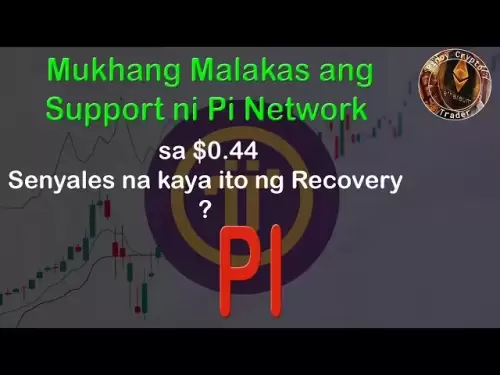-
 Bitcoin
Bitcoin $108,708.8110
0.60% -
 Ethereum
Ethereum $2,561.6057
1.91% -
 Tether USDt
Tether USDt $1.0001
-0.03% -
 XRP
XRP $2.2795
0.57% -
 BNB
BNB $662.2393
1.00% -
 Solana
Solana $153.1346
3.74% -
 USDC
USDC $1.0000
0.00% -
 TRON
TRON $0.2877
0.97% -
 Dogecoin
Dogecoin $0.1710
3.93% -
 Cardano
Cardano $0.5871
1.61% -
 Hyperliquid
Hyperliquid $39.6663
1.68% -
 Sui
Sui $2.9032
0.79% -
 Bitcoin Cash
Bitcoin Cash $496.1879
1.71% -
 Chainlink
Chainlink $13.5807
3.01% -
 UNUS SED LEO
UNUS SED LEO $9.0777
0.61% -
 Stellar
Stellar $0.2514
4.51% -
 Avalanche
Avalanche $18.1761
1.86% -
 Shiba Inu
Shiba Inu $0.0...01173
1.72% -
 Toncoin
Toncoin $2.8010
-4.23% -
 Hedera
Hedera $0.1594
3.21% -
 Litecoin
Litecoin $87.0257
-0.53% -
 Monero
Monero $319.1217
1.79% -
 Polkadot
Polkadot $3.3853
0.68% -
 Dai
Dai $0.9999
-0.01% -
 Ethena USDe
Ethena USDe $1.0003
0.02% -
 Bitget Token
Bitget Token $4.3420
-0.97% -
 Uniswap
Uniswap $7.3772
1.39% -
 Aave
Aave $286.6277
5.61% -
 Pepe
Pepe $0.0...09994
2.33% -
 Pi
Pi $0.4589
1.76%
What does the divergence between SUI's OBV indicator and price indicate?
SUI's OBV divergence from its price is a key signal for traders, indicating potential reversals; bullish when OBV rises as price falls, bearish when OBV falls as price rises.
Apr 25, 2025 at 03:28 am
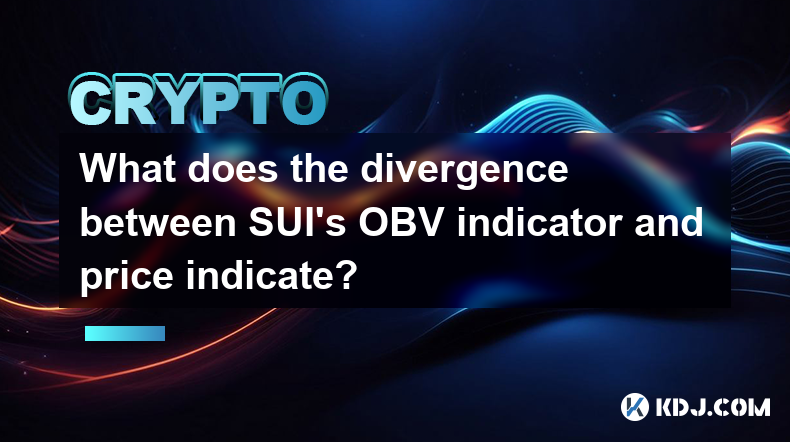
The divergence between SUI's On-Balance Volume (OBV) indicator and its price is a critical signal that traders and analysts often look at to predict future price movements. In the world of cryptocurrency, understanding these divergences can be the key to making informed trading decisions. This article will delve into what the OBV indicator is, how it is calculated, and what different types of divergences between the OBV and the price of SUI can indicate.
Understanding the On-Balance Volume (OBV) Indicator
The On-Balance Volume (OBV) indicator is a momentum indicator that uses volume flow to predict changes in stock or cryptocurrency prices. The core idea behind OBV is that volume precedes price movement. The OBV line increases when the volume on up days is greater than the volume on down days, and it decreases when the opposite is true. The formula for OBV is straightforward:
- If the current closing price is higher than the previous closing price, then: Current OBV = Previous OBV + Current Volume
- If the current closing price is lower than the previous closing price, then: Current OBV = Previous OBV - Current Volume
- If the current closing price is equal to the previous closing price, then: Current OBV = Previous OBV
Types of Divergences Between OBV and Price
Divergences occur when the price of an asset and the OBV indicator move in opposite directions. There are two main types of divergences to be aware of:
Bullish Divergence
Bullish divergence occurs when the price of SUI is making new lows, but the OBV is making higher lows. This indicates that despite the price moving downward, the volume is not confirming the downward trend, suggesting that the selling pressure is weakening. A bullish divergence can be a signal that a reversal to the upside may be imminent.
Bearish Divergence
Conversely, bearish divergence happens when the price of SUI is making new highs, but the OBV is making lower highs. This indicates that the price is rising, but the volume is not supporting the upward movement, suggesting that the buying pressure is weakening. A bearish divergence can signal that a reversal to the downside may be on the horizon.
Interpreting Divergence in SUI's Price and OBV
When analyzing the divergence between SUI's OBV and its price, it's essential to consider the context of the market and other technical indicators. Here are some steps to effectively interpret these divergences:
- Identify the Divergence: Look for instances where the price and OBV are moving in opposite directions. Use charting tools to plot both the price and OBV on the same chart for easier visualization.
- Confirm with Other Indicators: Use other technical indicators such as the Relative Strength Index (RSI) or Moving Averages to confirm the signals provided by the OBV divergence.
- Analyze the Volume: Pay close attention to the volume levels during the divergence period. High volume during a bullish divergence can strengthen the signal, while low volume during a bearish divergence can indicate a lack of conviction in the price movement.
- Watch for Breakouts: After identifying a divergence, monitor the price action for breakouts above resistance levels in the case of a bullish divergence or below support levels in the case of a bearish divergence.
Practical Examples of OBV Divergence with SUI
To illustrate how OBV divergence can be applied to SUI, let's consider two hypothetical scenarios:
Scenario 1: Bullish Divergence
In this scenario, SUI's price has been declining over the past few weeks, reaching new lows. However, the OBV has been making higher lows during the same period. This bullish divergence suggests that despite the falling prices, the volume is not confirming the downtrend. Traders might interpret this as a signal to look for buying opportunities, anticipating a potential reversal.
Scenario 2: Bearish Divergence
In this case, SUI's price has been climbing steadily, reaching new highs. However, the OBV has been making lower highs during the same period. This bearish divergence indicates that the rising prices are not supported by increasing volume. Traders might see this as a warning sign to consider taking profits or entering short positions, expecting a potential reversal.
Using OBV Divergence in Trading Strategies
Incorporating OBV divergence into trading strategies can enhance decision-making processes. Here are some ways traders might use this information:
- Entry and Exit Points: Use bullish divergences to identify potential entry points for long positions and bearish divergences to identify potential exit points or entry points for short positions.
- Risk Management: Adjust stop-loss orders based on the signals from OBV divergences to manage risk more effectively.
- Confirmation Tool: Use OBV divergence as a confirmation tool alongside other technical indicators to validate trading signals.
Limitations of OBV Divergence
While OBV divergence can be a powerful tool, it is not without its limitations. It's important for traders to be aware of these to avoid misinterpretation:
- False Signals: Like any technical indicator, OBV can produce false signals. Not every divergence will result in a price reversal.
- Lag: OBV is a lagging indicator, meaning it may not provide signals in real-time, which can affect the timeliness of trading decisions.
- Market Conditions: OBV divergence might work better in certain market conditions than others. For instance, it might be more reliable in trending markets than in range-bound markets.
Frequently Asked Questions
Can OBV divergence be used alone for trading decisions?
While OBV divergence can provide valuable insights, it is generally recommended to use it in conjunction with other technical indicators and fundamental analysis to make more informed trading decisions. Relying solely on OBV divergence might increase the risk of false signals.
How often should I check for OBV divergence?
It's advisable to check for OBV divergence regularly, especially during periods of significant price movement. Daily or weekly checks can help identify potential divergences, but the frequency can be adjusted based on your trading style and the volatility of SUI.
Is OBV divergence more reliable in certain market conditions?
OBV divergence tends to be more reliable in trending markets, where volume and price movements are more closely correlated. In range-bound markets, where prices move sideways, OBV divergence might be less effective and more prone to false signals.
What other indicators can complement OBV divergence?
Indicators such as the Relative Strength Index (RSI), Moving Averages, and the Moving Average Convergence Divergence (MACD) can complement OBV divergence. These indicators can help confirm signals and provide a more comprehensive view of the market.
Disclaimer:info@kdj.com
The information provided is not trading advice. kdj.com does not assume any responsibility for any investments made based on the information provided in this article. Cryptocurrencies are highly volatile and it is highly recommended that you invest with caution after thorough research!
If you believe that the content used on this website infringes your copyright, please contact us immediately (info@kdj.com) and we will delete it promptly.
- Bitcoin Wallet Hack? Coinbase Exec Sounds the Alarm on $8B Whale Movement
- 2025-07-07 18:30:12
- Mercado Bitcoin, Tokenization, and XRP Ledger: A Latin American Power Play
- 2025-07-07 18:30:12
- XYZVerse, Wall Street, and the Crypto Upswing: What's the Deal?
- 2025-07-07 19:10:12
- AI, Web3, and Communities: Building the Future Together
- 2025-07-07 19:10:12
- AurealOne: A Promising Early-Stage Metaverse Project
- 2025-07-07 19:15:12
- Dogecoin Price: Crypto Market Analysis and the Musk Effect
- 2025-07-07 19:50:12
Related knowledge
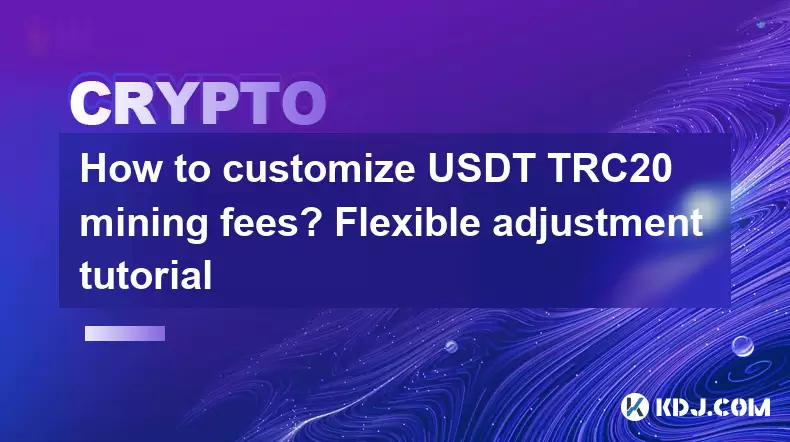
How to customize USDT TRC20 mining fees? Flexible adjustment tutorial
Jun 13,2025 at 01:42am
Understanding USDT TRC20 Mining FeesMining fees on the TRON (TRC20) network are essential for processing transactions. Unlike Bitcoin or Ethereum, where miners directly validate transactions, TRON uses a delegated proof-of-stake (DPoS) mechanism. However, users still need to pay bandwidth and energy fees, which are collectively referred to as 'mining fe...
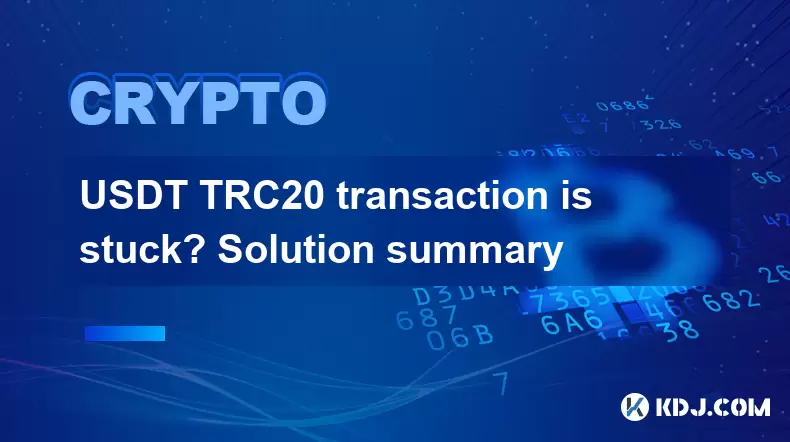
USDT TRC20 transaction is stuck? Solution summary
Jun 14,2025 at 11:15pm
Understanding USDT TRC20 TransactionsWhen users mention that a USDT TRC20 transaction is stuck, they typically refer to a situation where the transfer of Tether (USDT) on the TRON blockchain has not been confirmed for an extended period. This issue may arise due to various reasons such as network congestion, insufficient transaction fees, or wallet-rela...
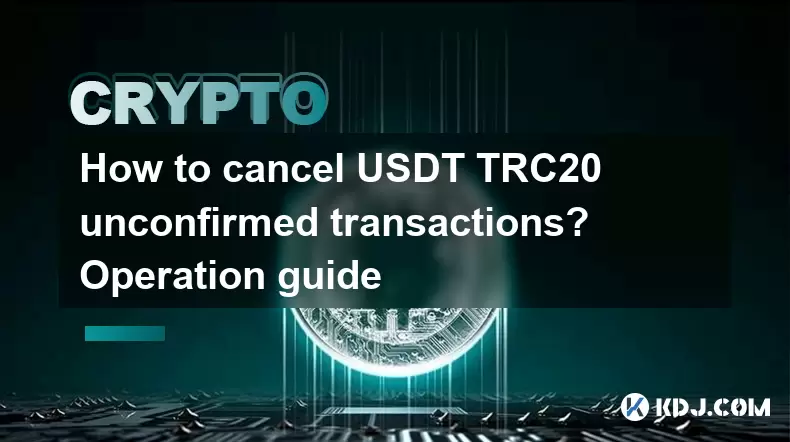
How to cancel USDT TRC20 unconfirmed transactions? Operation guide
Jun 13,2025 at 11:01pm
Understanding USDT TRC20 Unconfirmed TransactionsWhen dealing with USDT TRC20 transactions, it’s crucial to understand what an unconfirmed transaction means. An unconfirmed transaction is one that has been broadcasted to the blockchain network but hasn’t yet been included in a block. This typically occurs due to low transaction fees or network congestio...
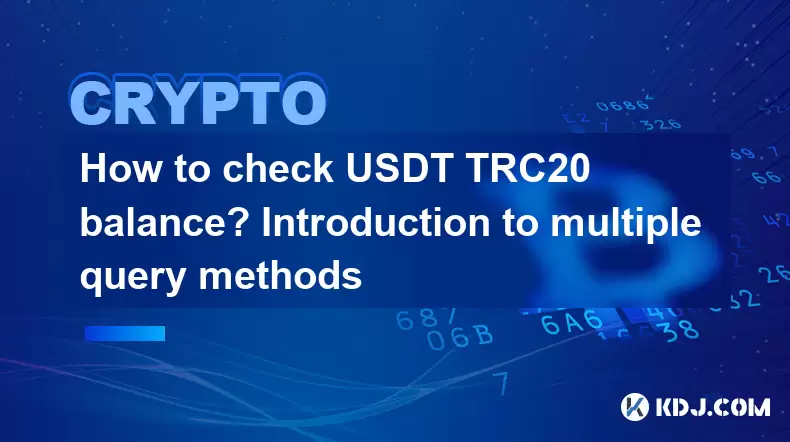
How to check USDT TRC20 balance? Introduction to multiple query methods
Jun 21,2025 at 02:42am
Understanding USDT TRC20 and Its ImportanceUSDT (Tether) is one of the most widely used stablecoins in the cryptocurrency market. It exists on multiple blockchain networks, including TRC20, which operates on the Tron (TRX) network. Checking your USDT TRC20 balance accurately is crucial for users who hold or transact with this asset. Whether you're sendi...
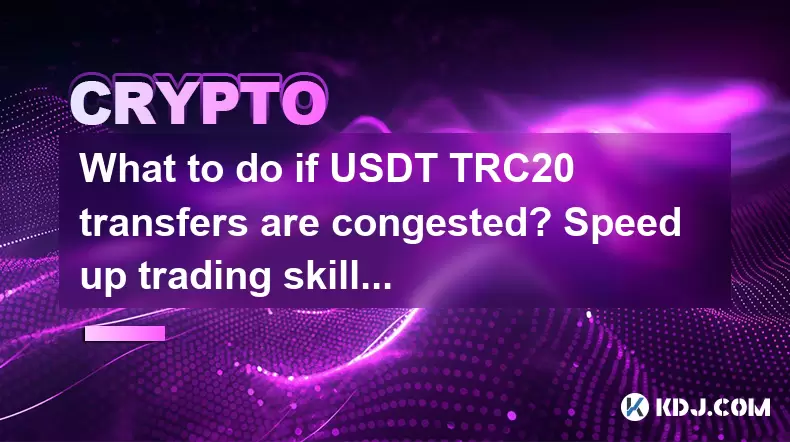
What to do if USDT TRC20 transfers are congested? Speed up trading skills
Jun 13,2025 at 09:56am
Understanding USDT TRC20 Transfer CongestionWhen transferring USDT TRC20, users may occasionally experience delays or congestion. This typically occurs due to network overload on the TRON blockchain, which hosts the TRC20 version of Tether. Unlike the ERC20 variant (which runs on Ethereum), TRC20 transactions are generally faster and cheaper, but during...
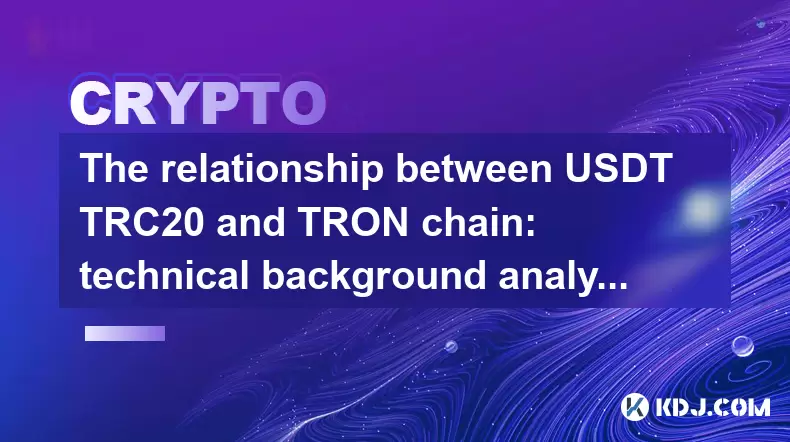
The relationship between USDT TRC20 and TRON chain: technical background analysis
Jun 12,2025 at 01:28pm
What is USDT TRC20?USDT TRC20 refers to the Tether (USDT) token issued on the TRON blockchain using the TRC-20 standard. Unlike the more commonly known ERC-20 version of USDT (which runs on Ethereum), the TRC-20 variant leverages the TRON network's infrastructure for faster and cheaper transactions. The emergence of this version came as part of Tether’s...

How to customize USDT TRC20 mining fees? Flexible adjustment tutorial
Jun 13,2025 at 01:42am
Understanding USDT TRC20 Mining FeesMining fees on the TRON (TRC20) network are essential for processing transactions. Unlike Bitcoin or Ethereum, where miners directly validate transactions, TRON uses a delegated proof-of-stake (DPoS) mechanism. However, users still need to pay bandwidth and energy fees, which are collectively referred to as 'mining fe...

USDT TRC20 transaction is stuck? Solution summary
Jun 14,2025 at 11:15pm
Understanding USDT TRC20 TransactionsWhen users mention that a USDT TRC20 transaction is stuck, they typically refer to a situation where the transfer of Tether (USDT) on the TRON blockchain has not been confirmed for an extended period. This issue may arise due to various reasons such as network congestion, insufficient transaction fees, or wallet-rela...

How to cancel USDT TRC20 unconfirmed transactions? Operation guide
Jun 13,2025 at 11:01pm
Understanding USDT TRC20 Unconfirmed TransactionsWhen dealing with USDT TRC20 transactions, it’s crucial to understand what an unconfirmed transaction means. An unconfirmed transaction is one that has been broadcasted to the blockchain network but hasn’t yet been included in a block. This typically occurs due to low transaction fees or network congestio...

How to check USDT TRC20 balance? Introduction to multiple query methods
Jun 21,2025 at 02:42am
Understanding USDT TRC20 and Its ImportanceUSDT (Tether) is one of the most widely used stablecoins in the cryptocurrency market. It exists on multiple blockchain networks, including TRC20, which operates on the Tron (TRX) network. Checking your USDT TRC20 balance accurately is crucial for users who hold or transact with this asset. Whether you're sendi...

What to do if USDT TRC20 transfers are congested? Speed up trading skills
Jun 13,2025 at 09:56am
Understanding USDT TRC20 Transfer CongestionWhen transferring USDT TRC20, users may occasionally experience delays or congestion. This typically occurs due to network overload on the TRON blockchain, which hosts the TRC20 version of Tether. Unlike the ERC20 variant (which runs on Ethereum), TRC20 transactions are generally faster and cheaper, but during...

The relationship between USDT TRC20 and TRON chain: technical background analysis
Jun 12,2025 at 01:28pm
What is USDT TRC20?USDT TRC20 refers to the Tether (USDT) token issued on the TRON blockchain using the TRC-20 standard. Unlike the more commonly known ERC-20 version of USDT (which runs on Ethereum), the TRC-20 variant leverages the TRON network's infrastructure for faster and cheaper transactions. The emergence of this version came as part of Tether’s...
See all articles























